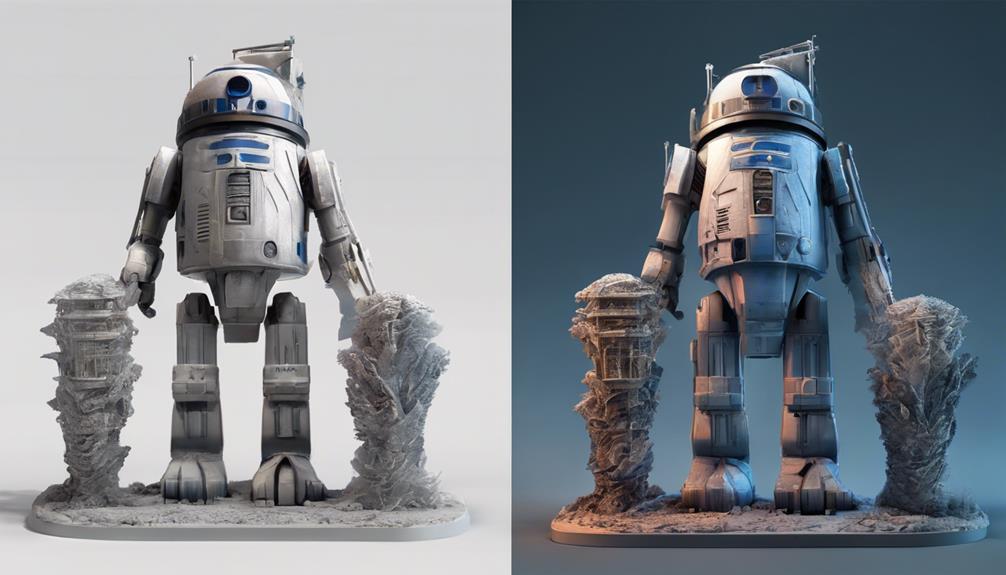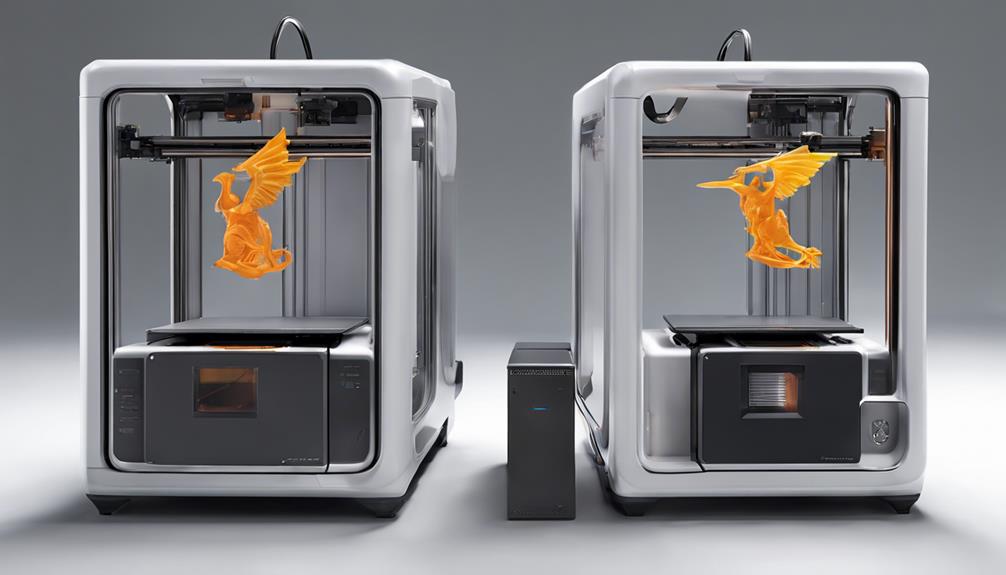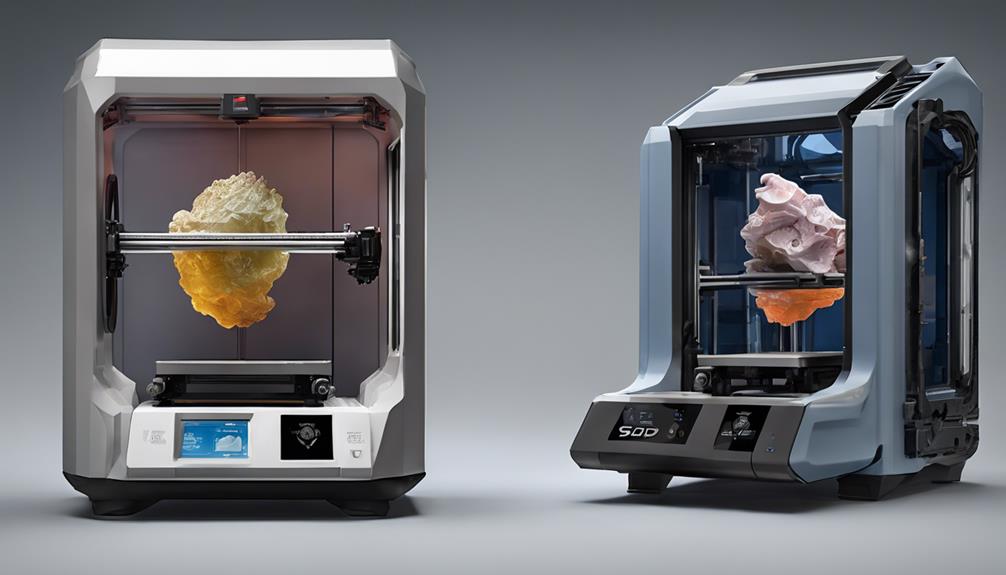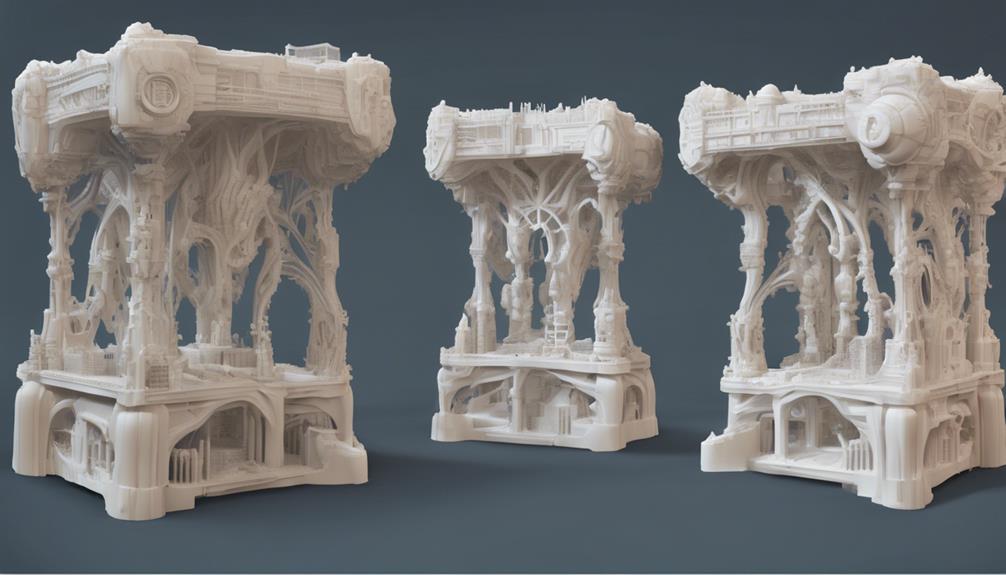The world of 3D printing for terrain enthusiasts presents an important decision point: FDM versus resin technology. Each offers distinct advantages, from intricate detailing to larger build volumes. However, the choice between these two types of printers extends beyond surface-level features. To truly understand which option can elevate your terrain projects to the next level requires a deeper exploration into the nuances of precision, cost, speed, and capacity. Revealing the top terrain 3D printers in the FDM and resin categories will shed light on the pivotal factors that can influence your decision-making process.
Precision and Quality Comparison

When evaluating precision and quality in 3D printing technologies, resin printers stand out for their exceptional accuracy and detailed reproduction capabilities driven by laser technology. Resin printers can achieve resolutions as low as 0.01 mm, surpassing the precision levels of FDM printers. This precision makes resin printers ideal for printing small, intricate objects that require high levels of detail.
On the other hand, FDM printers lack the same level of precision due to the visible layer lines formed during the printing process, making them unsuitable for tasks requiring intricate details like orthodontics. Essentially, the laser technology employed by resin printers guarantees a superior level of precision and quality in the final printed objects.
Price and Cost Analysis
In examining the financial aspects of 3D printing technologies, a significant consideration lies in the Price and Cost Analysis of utilizing resin and FDM printers. Resin printers typically cost around $350, while FDM printers are priced at $200, making FDM printers more budget-friendly initially.
However, resin material is approximately 10 times more expensive than PLA filament, leading to higher ongoing operational costs. Failed resin prints can further escalate overall printing expenses, and the cost of isopropyl alcohol for resin printer cleaning adds to the total cost.
In contrast, filament printers like FDM are generally cheaper to operate and maintain, making them a more cost-effective option in the long run.
Speed and Efficiency Evaluation

Speed and efficiency in 3D printing processes play an important role in determining the overall productivity and quality of printed objects. FDM printers are typically faster than resin printers but might compromise on print quality. On the other hand, resin printers are slower but provide a definitive finish to printed objects.
When it comes to printing terrains with small details important for accuracy, resin printers excel due to their superior precision. FDM printers, however, struggle with quickly producing intricate details and may require several days to complete high-quality prints.
As such, the choice between FDM and resin printers for terrain printing should take into consideration the balance between speed and the level of detail required in the final printed objects.
Capacity and Volume Consideration
Considering the role of speed and efficiency in 3D printing processes, the discussion now shifts towards evaluating the capacity and volume aspects of different printers for terrain printing. FDM printers generally offer larger build volumes compared to resin printers, making them more suitable for printing terrains that require significant space. The average FDM build volume is around 20x20x20 cm, while resin printers typically have smaller build volumes, approximately 12x8x16 cm. Some FDM printers even provide larger build volumes of 30x30x30 cm at slightly higher costs, catering to the needs of terrain enthusiasts who require ample space for their creations.
| Printer Type | Average Build Volume |
|---|---|
| FDM | 20x20x20 cm |
| Resin | 12x8x16 cm |
Recommended Terrain 3D Printers

With precision and efficiency in mind, selecting the best 3D printers for terrain printing is essential for achieving high-quality results. Among the recommended terrain 3D printers are:
- Prusa I3 MK3s+
- Ender 3 S1 and S1 Pro
- Creality CR-30
- Artillery Genius Pro
- TRONXY X5SA Pro
- Creality CR-6 Max
- Prusa Mini+
- Anycubic Kobra Max
- Anycubic Photon M3 Max
- Prusa SL1S SPEED
- Elegoo Mars 3 Ultra 4K
These printers offer a combination of features suitable for producing detailed terrains with accuracy and finesse. Each of these models comes equipped with capabilities that cater to the specific requirements of terrain printing, ensuring that hobbyists and professionals alike can achieve the desired results efficiently and effectively.
Printer Features and Specifications Overview
To further investigate the capabilities of the recommended terrain 3D printers, it is imperative to examine the detailed features and specifications of each model, highlighting their unique attributes for terrain printing enthusiasts.
The Prusa I3 MK3s+ boasts a large build volume of 25x21x21 cm, precision up to 50 microns, and compatibility with various filament types.
Ender 3 S1 and S1 Pro offer a build volume of 22x22x25 cm and 25x25x28 cm, respectively, with a resolution of 0.1 mm.
Creality CR-30 stands out with a 20x30x30 cm build volume and 0.05 mm layer resolution.
Each printer presents distinct advantages, such as speed, precision, and volume, catering to different terrain printing needs.
Choosing Between FDM and Resin

For those seeking the most suitable 3D printing technology for terrain models, a critical decision between FDM and Resin printers must be carefully evaluated.
FDM printers are cost-effective and better suited for larger terrains due to their larger build volumes. They are faster but compromise on print quality compared to Resin printers.
Resin printers, on the other hand, offer superior precision and are ideal for printing small, detailed objects with intricate features vital for terrains. While Resin printers are slower and more expensive, they excel in achieving high resolutions as low as 0.01 mm.
Ultimately, the choice between FDM and Resin printers hinges on factors like budget, desired level of detail, and the size of terrain models to be printed.
Frequently Asked Questions
Can Resin Printers Be Used for Printing Large-Scale Terrains?
Resin printers are not ideal for large-scale terrains due to limited build volumes. Their strength lies in intricate details, not expansive projects. FDM printers, with larger build volumes, are better suited for printing extensive terrains efficiently.
How Do I Minimize Failed Resin Prints to Control Costs?
To minimize failed resin prints and control costs, guarantee proper leveling, resin exposure times, and cleaning procedures. Use quality resins and follow manufacturer guidelines meticulously. Regularly calibrate your printer and monitor resin levels to prevent interruptions and wastage.
Are There Affordable Options for High-Resolution FDM Printers?
Affordable high-resolution FDM printers are essential for detailed terrain printing. Opt for precision with models like Prusa I3 MK3s+ or Ender 3 S1. Initial FDM investment aids in cost efficiency before shifting to resin printing for superior quality.
Which Primer Brand Is Most Suitable for Painting 3D Prints?
For painting 3D prints, Tamiya, Revell, and Krylon are recommended primer brands. Tamiya offers versatile products for hobbyists and professionals. Revell provides high-quality paints for realistic finishes. Krylon's wide range suits automotive and industrial applications, ensuring suitable priming solutions.
What Are the Potential Challenges When Switching From FDM to Resin Printing for Terrains?
Shifting from FDM to resin printing for terrains may present challenges in adapting to resin's slower speed, higher material costs, and meticulous cleaning requirements. Precision gains are notable, but cost-effectiveness and workflow adjustments are key considerations.
Conclusion
To sum up, the decision between FDM and resin 3D printers for terrain printing depends on factors such as precision, cost, speed, and volume requirements.
While resin printers excel in detail, FDM printers offer larger build volumes and faster printing speeds.
One potential objection may be the initial investment in a resin printer, but the long-term benefits of superior detail and quality may outweigh the upfront cost for dedicated terrain enthusiasts.